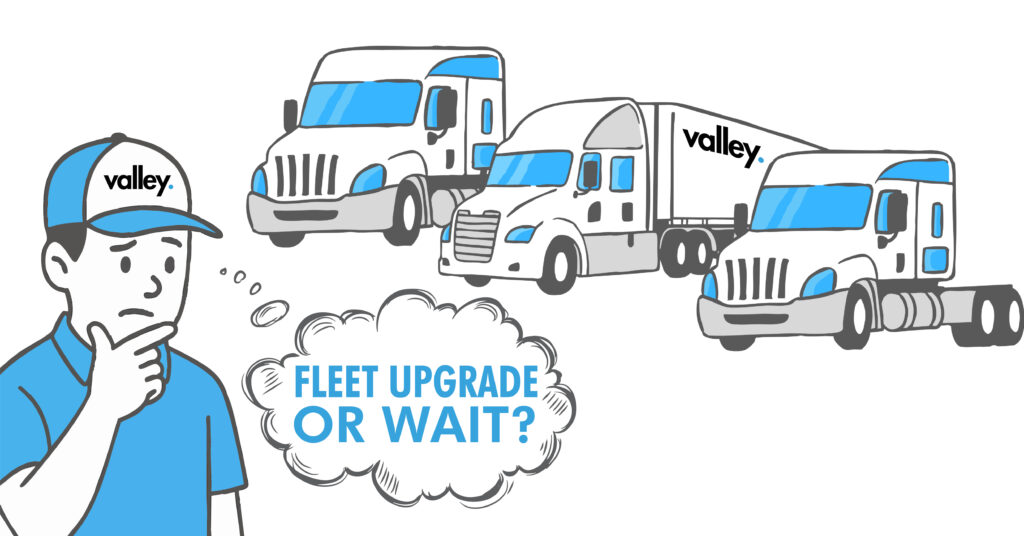Fleet Upgrade or Wait for the Right Time?

Deciding when to make a fleet upgrade is one of the biggest financial calls in trucking. New trucks come with a steep price tag, but keeping older ones too long can quietly destroy profit through repairs, downtime, and fuel waste. The trick is knowing when waiting costs more than investing.
Quick Answer
Smart fleets use fleet upgrade timing to cut costs and control risk. When the total cost per mile on an older truck exceeds that of a replacement, the upgrade pays for itself. In 2025, fleets that base decisions on cost data, safety tech, and fuel savings are staying ahead.
Why Timing Matters
Every year of delay adds hidden expenses. Maintenance, parts, and repair labor rise steadily as trucks age, and downtime disrupts delivery schedules. A FleetOwner analysis shows that proactive replacement strategies help fleets reduce unplanned maintenance and stabilize operating budgets.
Meanwhile, the American Transportation Research Institute (ATRI) found that maintenance and repair costs climbed again in early 2025, despite lower fuel prices. That means waiting longer before upgrading no longer guarantees savings.
Finally, a recent FreightWaves report highlights that fleets adopting newer, fuel-efficient models are offsetting payments faster than expected thanks to improved aerodynamics and technology.
When Delaying Costs More
A Midwest logistics company decided to stretch the life of its fleet to avoid loan payments. The plan worked for a while, until repair bills skyrocketed. Drivers grew frustrated with breakdowns, and on-time rates dropped. After upgrading to newer, safer trucks, operating costs fell 12 percent within a year, and morale improved.
This is what most carriers learn the hard way: the “cheap year” before replacement often becomes the most expensive one.
How to Decide With Confidence
Model Total Cost of Ownership
Include fuel, repairs, downtime, insurance, and resale value. When per-mile costs on an older truck pass the expected costs of a replacement, upgrading is justified.
Track Maintenance Trends
Maintenance spending usually accelerates after year 6 or 7. Tracking shop data helps identify your tipping point early.
Calculate Fuel Savings Payback
Better engines and aero kits can raise MPG by 0.5 to 1.0, saving thousands annually. Multiply expected gallons by your average price per gallon to estimate payback time.
Factor in Safety Technology
New trucks feature advanced driver-assistance systems, braking support, and blind-spot monitoring. These lower crash risk and can reduce insurance premiums when paired with telematics reports.
Choose the Right Financing
Match lease or loan terms to your planned holding period. Avoid paying past the repair-heavy years.
Replace in Phases
Upgrade by age, route, or utilization group. Phasing keeps cash flow steady and prevents downtime spikes.
Spec for Your Duty Cycle
Choose specs that fit your actual work. Over-spec’ing adds weight and fuel costs, under-spec’ing accelerates wear.
Upgrades as Risk Strategy
A modern fleet upgrade improves safety, compliance, and reliability. Fleets that document fewer breakdowns and better performance often receive favorable insurance reviews and stronger shipper confidence.
Turning Investment Into Advantage
When done right, upgrades cut cost per mile, improve uptime, and raise driver satisfaction. Carriers using lifecycle data to time replacements report better margins and retention, proving that timing isn’t just about saving money, it’s about positioning for growth.
Common Mistakes to Avoid
- Waiting for failures to force decisions
- Replacing all trucks at once
- Ignoring resale windows
- Overlooking safety and insurance benefits
- Using outdated cost models
Looking Ahead
In 2025, fleets face new emissions standards and tighter margins. Those who time upgrades correctly will stay competitive while others wrestle with aging equipment and higher repair exposure. The best strategy combines data, discipline, and timing.
FAQs
How often should fleets replace trucks?
- Most long-haul fleets replace units every five to seven years, depending on mileage and maintenance history.
Do safety upgrades really lower insurance?
- Yes. Documented reductions in incidents can support lower premiums and faster renewals.
What’s the fastest way to prove ROI?
- Track cost per mile, downtime, and fuel usage before and after replacement.
Can small fleets afford phased upgrades?
- Yes. Replacing a few high-cost units first helps fund future waves.
Should fleets buy or lease?
- It depends on tax position and cycle time. Leasing adds flexibility; ownership builds equity.
Final Thoughts
A fleet upgrade is not an expense, it’s a long-term risk and cost strategy. Replacing at the right time reduces total cost of ownership, improves driver morale, and builds operational resilience. The data is clear: proactive fleets perform better.
